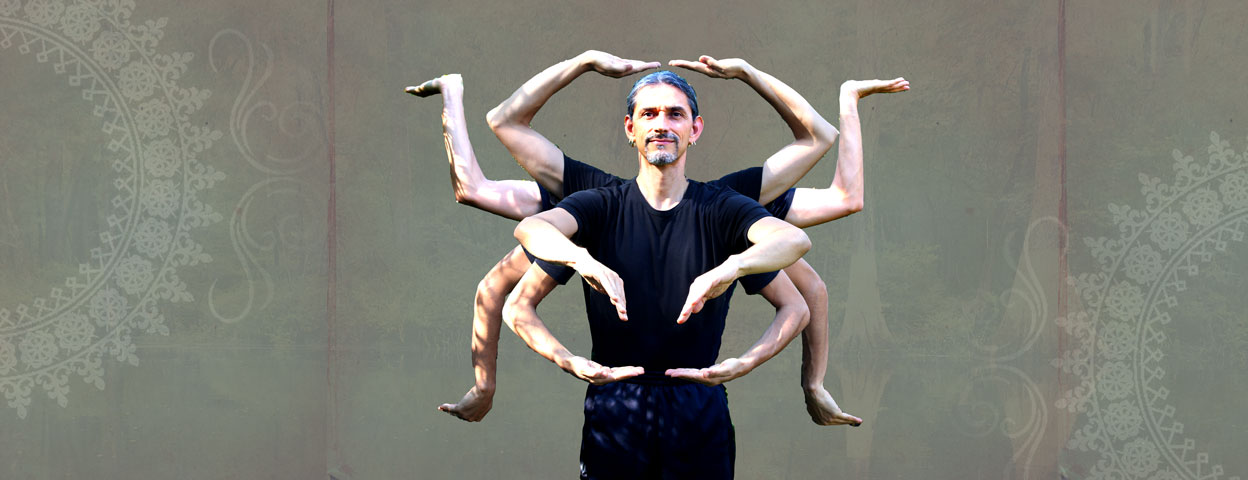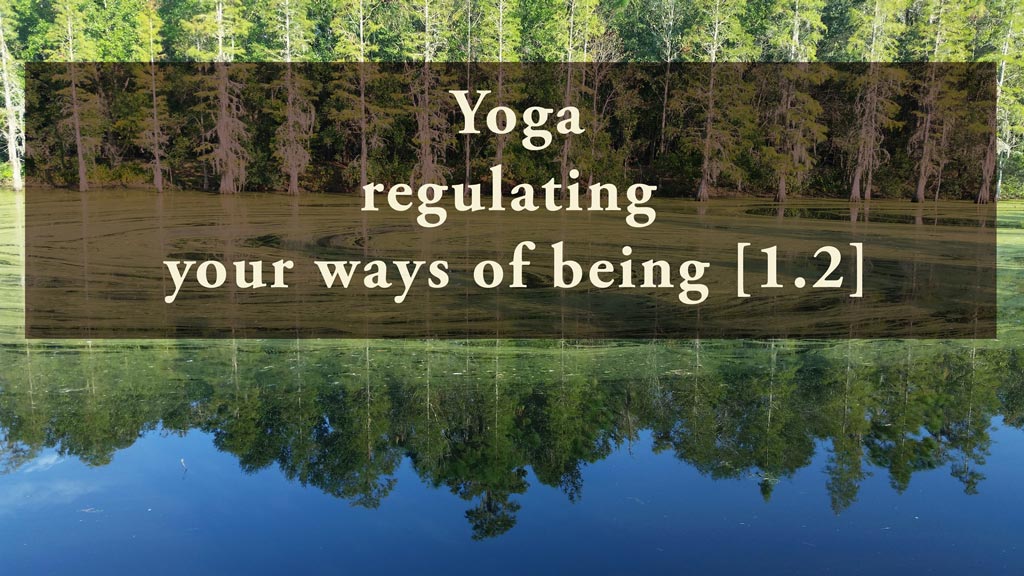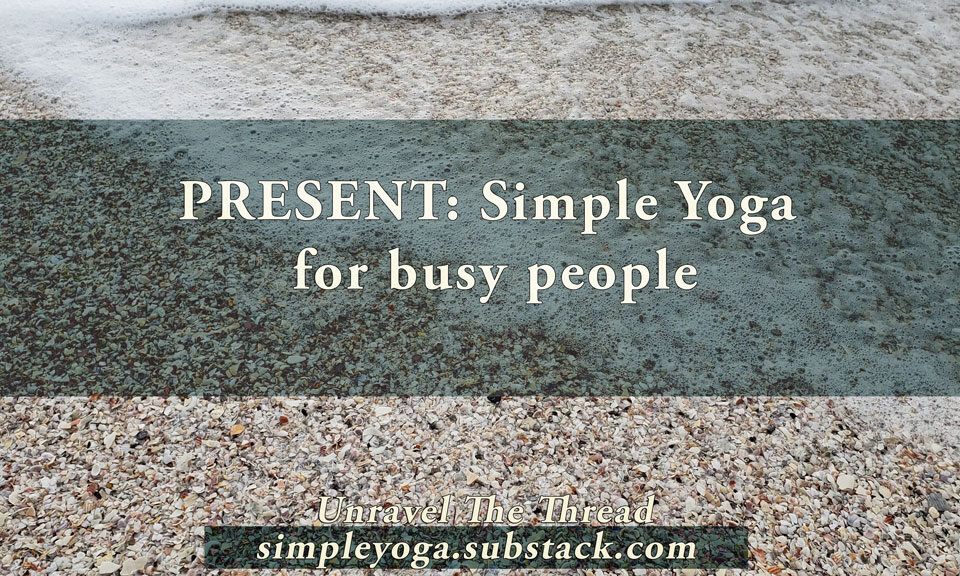Smart and Enjoyable Yoga Practice
February 7, 2019
Dance of Shiva: Transquarter
March 13, 2019Smart and Enjoyable Yoga Practice
February 7, 2019
Dance of Shiva: Transquarter
March 13, 20191.2 Yoga: Regulating ways of being


In a previous post, What is Yoga?, we explored this definition of yoga. One way to interpret it is to see yoga as a process of self-regulation. Yoga is a complete system to explore your body, your breath, your mind, your emotions, and your relationships. Since you are not a machine made up of separate parts, but an organism that developed from a fertilized cell, these different aspects of you are interconnected and can influence one another. At the same time, you are connected to everything that exists. There is never a time when you are not interacting, consciously or unconsciously, with the world around you.
Remember that “ways of being” are your internal activities and the tendencies they generate. Ways of being also include your inclinations. Yoga is a method, consisting of tools that help us modulate our ways of being because some ways of being may be beneficial in one context but not very helpful in others. For example, being flexible in your taste and preferences can make you adaptable. However, the same trait can be an obstacle when trying to make decisions and follow through on them. The yoga perspective asks you to notice what you are doing in order to clarify what contributes to presence and what doesn’t. Knowing the distinction between the two is a fundamental skill enabling us to downregulate unhelpful ways of being to make life affirming decisions.
Additionally, since there is a tendency for many of us to get distracted and entangled in our sensations, emotions, thoughts and stories, yoga teaches us to monitor and regulate these tendencies. The literal translation of yoga as yoking suggests bringing together our body, breath, mind and emotions to enhance the quality of our participation in our own lives.
For instance, most of us pay some attention to the weather, even just by looking out through our window for the practical purpose of making intelligent choices, like taking along an umbrella if it seems like it will rain. A simple weather event like rain can generate two quite distinct reactions in the same person. For example, if I am working on my garden and I recently finished planting seeds in the ground, I may be quite happy when it starts raining. On the other hand, if I have plans to meet my friends for a picnic, I may feel frustrated or upset about having to change or cancel my plans when it rains. Same person, same meteorological event, but two very different reactions.
Most of us would probably agree that when the weather outside aligns with our preferences, we feel happy, or at least in a good mood. Of course, it is easier to feel happy when everything is going according to our liking. However, when the weather turns, does that make our mood turn as well? Is the person who finds today’s weather lovely, the same person that complains tomorrow because it is too hot, too humid, too cold, too windy or too rainy?
How do you react to the weather outside? One tendency may be to want to control the weather. Another would be to try to predict everything that could happen. While the first approach may cause frustration because we can’t control what is happening outside ourselves, the second option tends to generate anxiety because we might be constantly trying to make sure that we have accounted for all possible outcomes. From the perspective of self-regulation it is critical to distinguish what is within and what is beyond our control. Worrying about what is beyond our control is clearly a waste of energy.
Then, we can turn our attention to what is within our control. Here is where the tools of yoga can provide insight. Practicing the wise guidelines for behavior known as the yamas and niyamas, we may find that it is challenging to act with kindness and contentment all of the time. Practicing postures and movements (asana and vinyasa) can show us that we have limited control over our body. Practicing the breath regulation techniques (pranayama) can show the limits of our ability to control our breathing processes. Attempting to practice inner sensitivity (pratyahara) may demonstrate our shortcomings in mastering our senses. Practicing concentration (dharana) and meditation (dhyana) will likely show us that it is quite difficult to keep our attention in one place even for just 3 or 4 minutes. All of these tools of yoga are directed to remove inefficiencies. In fact, every yoga technique will likely uncover inefficiencies and obstacles and will facilitate their removal. In the process we will likely learn also some humility.
Moreover, learning to shift our attention from trying to control the world outside to directing our energy where it can be effective -our internal environment, we will be able to notice how external events beyond our control influence how we feel and think. Letting our attitude and outlook be at the mercy of external phenomena is a recipe for being on a constant emotional roller coaster.
This definition of yoga is asking: Is it possible for you to regulate your own internal climate, by choosing how you respond to what is happening outside? Seeing yoga as a system to regulate your ways of being means that yoga practice enhances your ability to respond congruently to your life. In that way, yoga practice empowers you to become responsible for your own internal climate.
In summary, we start by becoming aware of our ways of being. Then, we let go of what is beyond our control. The next step is to notice what is within our control. With playful curiosity we learn to modulate our attitude, body, breath, senses and mind. The more attuned we are to our inner climate, the easier it will be to determine how our thoughts, emotions, movements, attitude, posture, movements and breath are influenced by what is happening outside. At the same time we increase the probabilities that we can learn how all of these aspects of ourselves influence our intentions, choices and actions.
One more way of thinking about this definition of yoga is that Yoga is being with what is. Put simply, instead of fighting this moment, you choose to accept this moment as it is, and yourself as you are. As you attempt to be in this moment, you notice if your ways of being, that manifest in your attitude, posture, movements, thoughts and emotions contribute to your wholehearted and unconditional participation in the moment you are in. If so, you continue flowing harmoniously with life and its ever-changing circumstances. Otherwise, if your ways of being are obstacles to presence, you are in charge of regulating your ways of being so that you can be fully present.
On the journey of yoga there are two options. The first is to be in the state of yoga, and the second is to move towards that state. Being in the state of yoga is being with what is as it is and with yourself as you are. The second is regulating your ways of being to move towards the state of yoga. You can do the latter by asking yourself, “Am I fully present?” You can also ask “How is this posture enhancing the quality of my participation? How is this movement contributing to my being present? How is this thought influencing my ability to show up to this moment? Does this attitude enhance my contribution to life? How is this way of breathing conducive to participate fully in this moment?” Notice that it is essential to be aware of your own ways of being in order to be able to regulate them. Thus, yoga requires you to be aware of your tendencies by noticing your inclinations and predispositions and then asking yourself, “Is this tendency useful right now?” and “Is this tendency helping me move towards presence?”
Of course, you can also choose to chant this sutra as a way to feel its vibrations directly in your own body and to reflect on all of these ideas. You can choose between the traditional version:
योगश्चित्तवृत्तिनिरोधः ॥२॥ 1.2 yogaścittavṛttinirodhaḥor, its simplified version with each word chanted individually:
- yogaḥ
- citta
- vṛtti
- nirodhaḥ
Unravel the thread is now available as a book!
If you find Simple-Yoga.org and Unravel the thread useful, consider supporting my labor with a donation, you may also donate using PayPal or Venmo. Thank you!
